Advanced link building techniques are essential in competitive niches like SaaS, finance, crypto, law, and health. These industries are dominated by brands with strong backlink profiles and high domain authority.
Basic strategies such as low-tier guest posts or directory submissions no longer deliver results. To compete effectively, you need a smarter, more strategic approach.
That includes analyzing competitor backlinks, securing placements on high-authority, niche-relevant websites, and amplifying rankings through multi-level link structures. AI-powered tools can also accelerate prospecting and personalization without sacrificing quality.
Modern campaigns focus on anchor diversity, clean link profiles, and contextual relevance to stay ahead of Google’s evolving algorithms.
In this guide, you’ll learn how to:
- Identify and close backlink gaps
- Build contextual links that pass real authority
- Use tiered strategies for stronger signal amplification
- Automate outreach safely and effectively
- Track link performance and stay penalty-safe
These advanced methods help you grow rankings in saturated markets where traditional link building fails.
What Makes a Niche “Tough” in SEO?
Tough niches are those where high-authority brands dominate SERPs and standard SEO tactics fail to make an impact. Success in these markets requires not just content—but precision link building, competitor deconstruction, and niche specialization.
Why These Niches Are Hard to Rank In:
- Big-budget competitors already hold most top-ranking positions.
- Limited link sources and strict editorial standards make backlink acquisition difficult.
- Google EEAT and YMYL policies demand authoritative references, especially in regulated fields.
- Content saturation means new sites are buried unless paired with strong links.
Real-World Examples of Competitive Niches:
- SaaS SEO: Competing with giants like Ahrefs, Semrush, and HubSpot, all of which dominate with link-rich educational content and partner networks.
- Healthcare & Medical: Competing with WebMD, Healthline, and government/edu portals. YMYL guidelines make this niche high-risk.
- Finance & Fintech: Dominated by NerdWallet, Investopedia, and Forbes. Even long-tail keywords often show heavy branded presence.
- Crypto & iGaming: Regulatory red flags limit outreach options, and Google scrutiny is higher than average.
- Legal Industry: Competing against decades-old firms listed in Justia, Avvo, and other citation-heavy aggregators.
Before starting any link building campaign, assess your niche carefully. If you’re in a saturated space, go deeper:
- Reverse-engineer your competitors’ link profiles to uncover what domains and strategies are giving them leverage.
- Break the niche into micro-segments (e.g., instead of SaaS, focus on project management tools for legal teams).
- Target long-tail SERPs with less noise and more opportunity—by leveraging white-hat link building techniques that work in difficult verticals.
This niche-awareness mindset ensures your link building effort isn’t wasted on battles you can’t win.
Competitive Link Gap & Authority Analysis
Link gap analysis is the process of finding websites that link to your competitors—but not to you. In competitive niches, this method helps uncover precise backlink opportunities instead of relying on random link outreach.
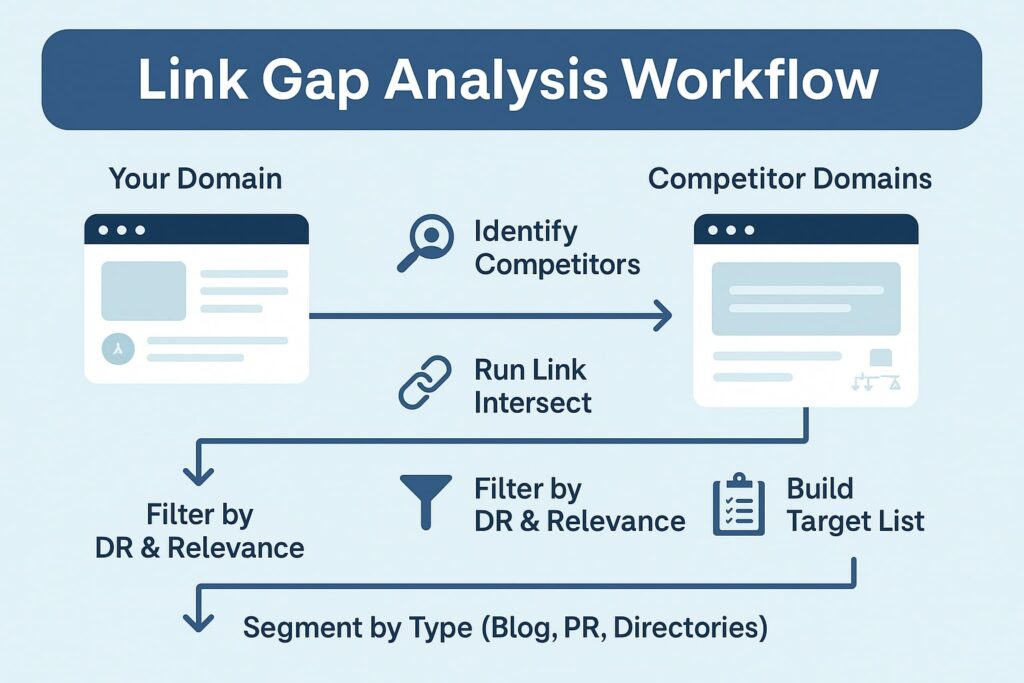
By using tools like Ahrefs or Semrush, you can compare backlink profiles across top-ranking pages. The goal is to build a target list of domains that influence rankings in your niche but are missing from your profile.
Here’s how to do it effectively:
- Use link intersect tools to find shared domains among competitors.
- Export and group domains by type: blogs, PR sites, directories, editorial mentions, etc.
- Evaluate quality using trust metrics like DR/DA, traffic estimates, and spam score.
- Prioritize contextual relevance—choose domains aligned with your niche or keyword theme.
- Analyze anchor text diversity in competitor links to find patterns Google favors.
- Filter out toxic domains using backlink audit tools—see this backlink analysis guide for key steps.
What Is Advanced Link Building?
Advanced link building is a high-level strategy that focuses on acquiring backlinks from authoritative, niche-relevant websites using customized outreach and content assets. Unlike traditional tactics, it prioritizes quality, context, and long-term impact over quick wins.
Basic link building methods such as blog comments, directory submissions, and generic guest posts still work to some extent. But in saturated niches, they rarely push you to the top of SERPs.
Examples of Traditional Link Building Tactics:
- Writing guest posts for general blogs
- Submitting your site to online directories
- Leaving blog comments with embedded links
- Sharing links on social bookmarking platforms
Why these tactics often fail in tough niches:
- They’re overused and easy to replicate
- Google’s EEAT and spam policies demand stronger trust signals
- High-authority competitors already dominate with more sophisticated strategies
What Sets Advanced Link Building Apart?
Advanced link building focuses on:
- Targeting link gaps with precision—see how to find competitor links you’re missing
- Building linkable assets like data studies, visuals, and tools
- Attracting editorial backlinks through niche-specific outreach
- Using tiered systems to amplify existing link equity
- Leveraging AI tools to scale prospecting and personalize outreach
These strategies require deeper industry understanding and content alignment, but they yield stronger domain authority, higher rankings, and sustainable traffic growth.
If your goal is to dominate a competitive niche, basic tactics won’t cut it. You need a strategy designed for the modern SEO landscape.
Want to explore sustainable methods? Read about these white-hat link building techniques that are designed to pass long-term value.
Proven Advanced Link Building Techniques for 2025
In a competitive search engine ecosystem, only advanced link building techniques can provide the edge needed to outrank established brands.These tactics go beyond outdated directory submissions or guest posts on irrelevant blogs. They are strategic, scalable, and aligned for industries where Google rewards quality, context, and authority.
Whether you’re operating in SaaS, health, finance, or legal—these techniques are designed to:
- Target the right domains based on backlink gap insights
- Earn contextual, editorial links through unique value
- Strengthen your existing link equity with multi-tiered amplification
- Adapt to Google’s evolving EEAT and spam detection standards
Each tactic in this section is selected for its real-world effectiveness in 2025—tested across high-competition niches and structured for scalable implementation.
6 Proven Link Building Techniques for 2025
1. Skyscraper + Link Baiting Hybrid
This advanced link building technique combines the power of the Skyscraper method with a strategic link bait element. Instead of just creating something “bigger,” you build something sharper, smarter, and designed to earn editorial links naturally.
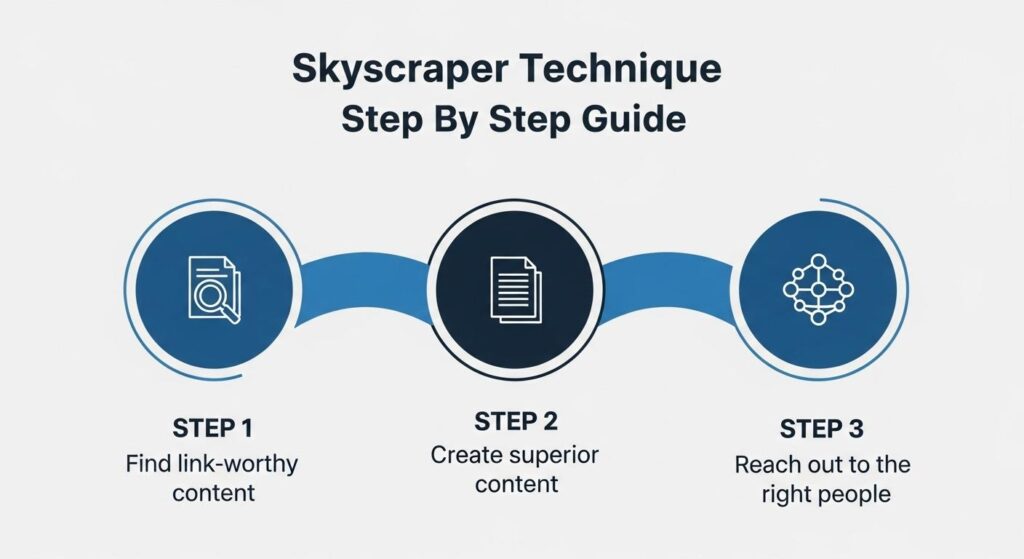
Practical Example: Outperform What’s Already Ranking
Let’s say you search for “best email marketing tools for small business” on Google.
You notice WPBeginner ranks first with a basic roundup. It’s ranking well, attracting links, but likely has weak points—like outdated tools, no pricing filters, or a lack of visual UX
Here’s how to build a stronger, link-worthy asset:
- Audit the competitor page
- Are all tools updated for 2025?
- Is pricing comparison missing?
- Any lack of user reviews, charts, or FAQs?
- Are all tools updated for 2025?
- Create a 10x better version
- Add screenshots, pros/cons, or use cases
- Include filters (e.g., for startups vs. agencies)
- Embed expert opinions or testimonials
- Improve structure with summary tables or collapsible FAQs
- Add screenshots, pros/cons, or use cases
- Insert a link bait element
- Downloadable PDF comparison chart
- Interactive quiz or tool selector
- Exclusive ROI calculator
- Survey data with citation value
- Downloadable PDF comparison chart
This layered content isn’t just “better”—it becomes referable, increasing your chances of backlinks from industry sites.
Tools to Support This Process
Use these tools to identify weaknesses, spot link opportunities, and design a higher-value asset:
- Ahrefs or Semrush
Analyze the original content’s backlinks, anchor text, and referring domains to gauge its strength. - BuzzSumo
Discover viral content formats and headlines that attract backlinks in your niche. - Surfer SEO or Frase
Optimize for on-page relevance, entity inclusion, and semantic coverage. - Google, Reddit, Quora
Source real user questions or missing subtopics from competitors. These platforms expose intent gaps and overlooked pain points.
Outreach and Distribution
Once your asset is live, target sites that already linked to the original content.
- Use backlink tools to extract referring domains from the original URL.
- Filter for DR40+ niche-relevant sites. Focus on editorial blogs, not directories or comment links.
- Craft short, personalized pitches. Mention what’s updated or exclusive in your piece.
- Offer value, not just a link ask. Frame your outreach as providing a better resource for their readers.
If you don’t get traction immediately, boost visibility by:
- Internally linking from other high-traffic blog posts
- Republishing parts on platforms like Medium or LinkedIn
- Embedding the asset inside guest posts or white-hat content clusters
Why This Technique Works
Rather than guessing what will attract links, you reverse-engineer success. You build something better based on what’s already proven to work—and offer it to the same audience.
- You follow data, not assumptions
- Editors get a compelling reason to link or update
- Your content gains authority through strategic promotion
2) Guestographics – A Visual Strategy for Scalable Link Building
Guestographics combine two powerful link-building tactics into one:
- A well-designed infographic
- A custom-written blog post for another website
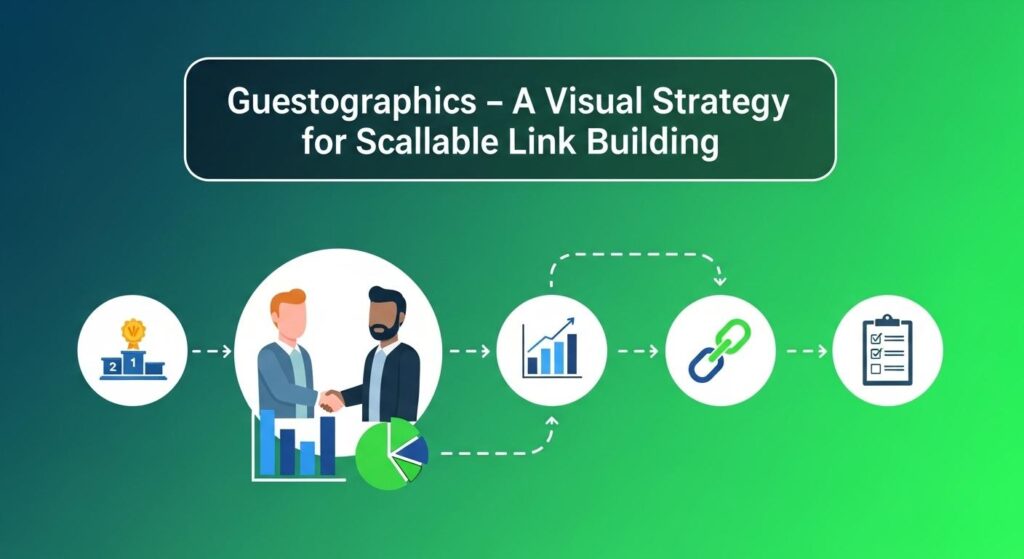
The idea is simple: you offer valuable visual content + written context to relevant blogs in exchange for a backlink. It’s more appealing than a plain guest post outreach because editors get both a visual asset and written content—ready to publish.
This approach works because:
- Most blogs don’t have time or design resources to create quality visuals
- Infographics improve user experience and time on page
- You can control the backlink placement, anchor text, and content theme
Real-World Example: Infographic Outreach in Action
Here’s a real example from Serpstat via Serpzilla showing exactly how this works:
This infographic explains:
- How backlinks affect rankings
- How long SEO takes to show results
- Forecasts on link value over the next five years
Now imagine you created this, published it on your blog, and pitched it to marketing websites with a short write-up. Each time a site embeds the infographic, you get a contextual, editorial backlink—often from highly relevant domains.
How to Create and Use Guestographics (Step-by-Step)
Step 1: Choose a Data-Driven Topic
Pick something visual-friendly: stats, timelines, step-by-step guides, comparisons.
Step 2: Design the Infographic
Use tools like Canva, Visme, or Venngage. Keep it clean, branded, and easy to read.
Step 3: Write the Accompanying Blog Post
300–600 words summarizing the infographic. Add insight, link naturally to your site, and match the tone of your outreach target.
Step 4: Outreach to Relevant Blogs
Use Google search operators or tools like BuzzSumo and Ahrefs to find potential publishers.
Example pitch:
“Hi [Name], we created a new infographic on [topic] and paired it with a short custom post. Would you be interested in publishing it?”
Step 5: Publish on Your Own Blog Too
Many websites naturally embed helpful visuals and credit the source—earning you passive backlinks over time.
Tips to Maximize Results from Guestographic Campaigns
- Offer multiple formats (JPG, PNG, and PDF) to make it easier for publishers to embed
- Repurpose the infographic into a LinkedIn carousel, SlideShare deck, or YouTube short
- Use niche edit outreach: If you see a blog covering a related topic, offer the infographic as an addition with a source link
- Track all embeds using reverse image search or Ahrefs’ “Backlinks > Images” filter
- Link to related assets like this guide on white-hat link building techniques to boost internal value and topical relevance
3) Broken Link Recovery in Authority Pages
Broken link recovery is a simple but powerful way to earn backlinks from trusted websites in hard-to-rank niches like law, health, SaaS, and finance. The strategy involves finding broken (404) links on high-authority blogs and replacing them with your updated and relevant content.
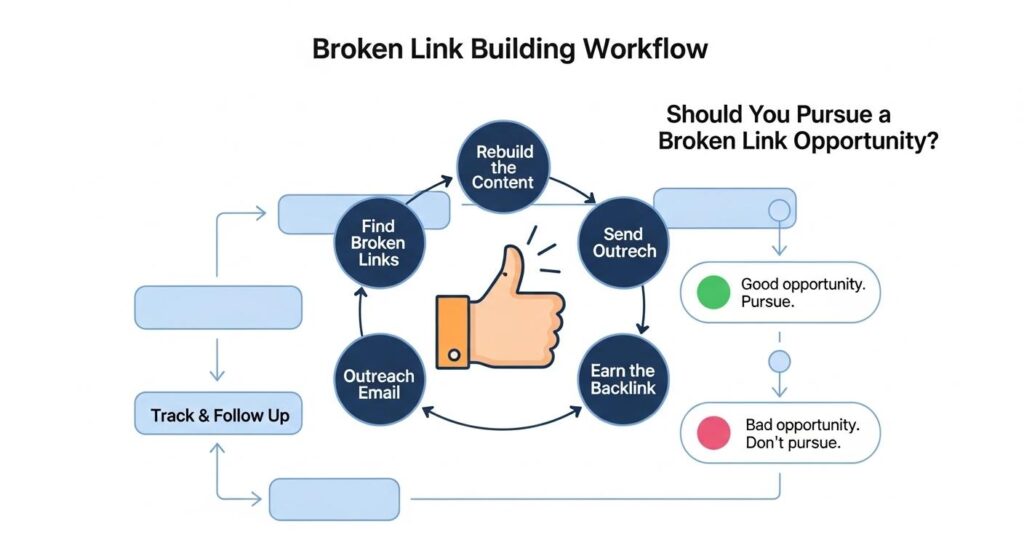
This method works well because it solves a real problem—broken links hurt user experience and SEO. By offering a helpful fix, you increase your chances of getting a link without pitching a full guest post.
Why This Strategy Works So Well
- Easier Outreach: Editors are more open to fixing broken links than publishing new content.
- High-Quality Placements: These links are often on resource pages or evergreen articles—perfect for SEO.
- Safe and Compliant: This technique follows Google’s guidelines and supports EEAT (Experience, Expertise, Authority, Trust), especially in sensitive industries.
How to Do Broken Link Recovery
1. Find Relevant Broken Links
Use tools like:
- Ahrefs → Check “Best by Links” and filter for “404 Not Found”
- Screaming Frog → Crawl target sites and find broken links
- Check My Links → Chrome extension for manual browsing
Look for:
- Websites with DR40+
- Pages in your niche (legal, SaaS, health, etc.)
- Active blogs or resource pages—not old or inactive domains
2. Rebuild the Content
Use the Wayback Machine to see what the original page looked like. Then, create a better version by adding:
- Updated facts or 2025 data
- Helpful visuals like charts or infographics
- Expert tips or citations for EEAT trust
Your goal is to improve on the original—not just copy it.
3. Send a Simple Outreach Email
Once your content is ready, reach out to the site owner. Be polite and to the point.
Example Email:
Subject: Found a Broken Link on Your Page Hi [First Name], I came across your page [insert URL] and noticed a broken link to [old URL]. We just created an updated version on the same topic, with new data and visuals. Here it is if you'd like to check it out: [your link] Happy to answer any questions! Best, [Your Name]
Here are the helpful tools with outbound links included for each:
Helpful Tools
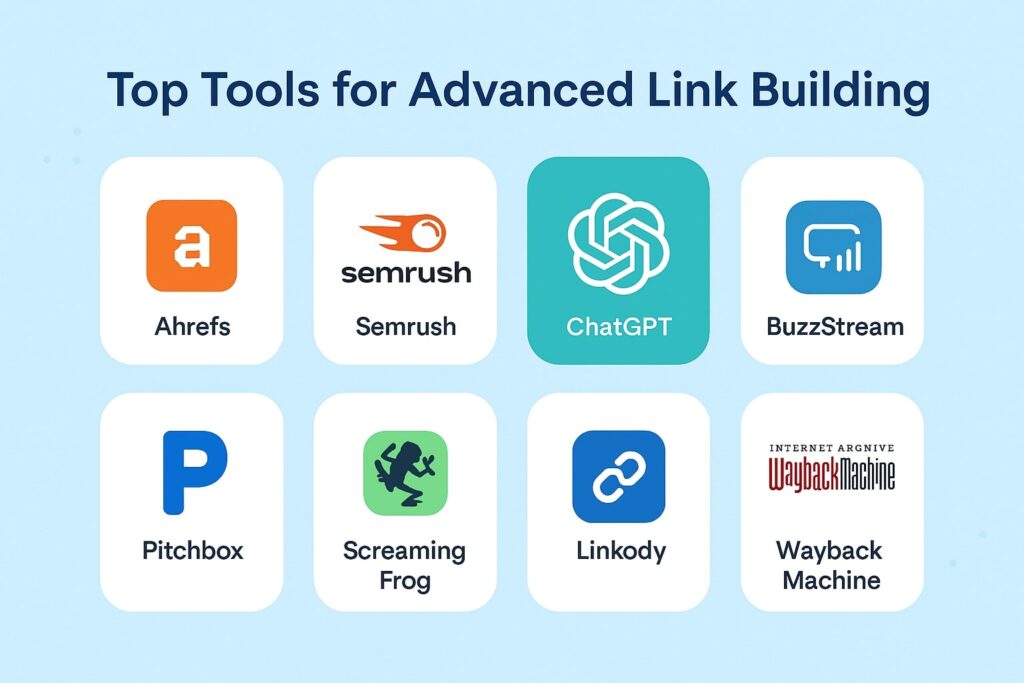
Top tools for advance link building
- Ahrefs – For finding 404 backlinks and analyzing competitor link gaps
- Wayback Machine – To view archived versions of broken or deleted pages
- Screaming Frog SEO Spider – To crawl websites and export broken link reports
- BuzzStream – To manage email outreach and track follow-ups
- Check My Links (Chrome Extension) – For quick manual checks of live pages for broken links
Need Help Finding Broken Link Opportunities?
🚀 Let T-RANKS do the heavy lifting.
Request your Free Link Audit today.
4) Round-Up Inclusion and Thought Leadership
This strategy earns high-quality backlinks by sharing short expert quotes instead of full guest posts. Editors include your name, link, and quote in expert roundups or interviews. It’s fast, scalable, and effective for tough niches like SaaS, finance, legal, and health.
Why This Works
- Quick wins: A 100-word quote can land a backlink from a DR70+ site
- Boosts E-E-A-T: Google values expert mentions in trusted publications
- Earns natural links: Editors add links voluntarily, not through payment
- Starts long-term relationships: One quote can lead to more features
How to Get Featured

1. Find Real-Time Opportunities
Sign up for platforms that connect experts with journalists:
- Connectively (formerly HARO)
- Qwoted
- SourceBottle
- BuzzSumo – to find trending roundup posts
Use Google searches like:
- “SaaS tips” inurl:roundup
- “crypto expert advice” + 2025
These help you find editors already working on roundup content.
2. Submit a Short, Helpful Quote
Reply with a concise tip, stat, or insight.
Example:
“We found that AI-driven onboarding improves SaaS conversions by 40%. Personalization in the first 7 days keeps users engaged.”
Include:
- Your name and role
- A link to your blog post, case study, or guide (e.g. “AI onboarding guide”)
- A personal touch (use the editor’s name, mention their blog)
3. Publish a Supporting Post
If your quote is about “SEO for law firms,” publish a related post on your site. Editors are more likely to link if your content expands on your insight.
4. Build Real Relationships
After getting published:
- Share the roundup on LinkedIn and tag the editor
- Send a thank-you email
- Offer future contributions
- Track the backlink with Ahrefs or Linkody
Why It Works
- No full article needed
- Natural editorial backlinks
- Builds trust and visibility in competitive spaces
- Ideal when cold guest post outreach fails
5) Tiered Link Amplification Strategy
Tiered link amplification boosts the strength of your best backlinks by building secondary and tertiary links that point to them. Instead of chasing new backlinks, you increase the power of existing ones. This technique is especially useful in hard-to-rank niches like SaaS, legal, iGaming, and finance.
This structure passes link equity upward, enhancing your site’s authority while keeping your domain insulated from risk. It’s a scalable and cost-efficient strategy when executed with quality control.
How Tiered Link Building Works
Tiered linking uses a three-layer structure:
- Tier 1: High-authority links pointing to your site. These should come from trusted, niche-relevant sources like guest posts, PR features, or expert contributions.
- Tier 2: Links that point to your Tier 1 placements. Examples include Medium posts, Quora answers, LinkedIn articles, or relevant forum posts.
- Tier 3: Foundational support pointing to Tier 2 pages. These are typically lower-impact links like social shares, blog comments, and directories—but they help drive indexation and crawl flow.
Why This Strategy Works for Tough Niches
- Amplifies Existing Link Equity: Each new tier boosts the layer above, strengthening your domain authority without relying on fresh Tier 1 links.
- Keeps Link Profile Safe: Low-quality or generic links are built to secondary layers, not your site—protecting you from penalties.
- Improves Indexation and Crawlability: Google finds and values your links faster with supporting layers behind them.
- Scales Authority Affordably: One strong guest post can be reused across multiple Tier 2 content pieces.
Execution Tips and Tools
1. Choose Strong Tier 1 Links
Use Ahrefs or SEMrush to find backlinks from DR40+ sites that are contextually relevant. Focus on guest posts, round-ups, and expert features with real organic traffic.
2. Build Tier 2 Using Contextual Platforms
Create content on platforms like Medium, Reddit, or LinkedIn Pulse. Link naturally to your Tier 1 placements using anchor text like “legal marketing insights” or “see full SaaS guide.”
3. Add Light Tier 3 Signals
Boost Tier 2 content visibility by:
- Sharing it on social platforms (X, Facebook, LinkedIn)
- Submitting it to content hubs like Scoop.it
- Adding it to niche Reddit threads or curated lists
Use nofollow and generic anchors to keep the pattern natural.
4. Monitor Link Health and Results
Use tools like:
- Linkody – to track live links and anchor diversity
- BuzzStream – to manage placements and outreach
- Screaming Frog – to crawl and audit Tier 2/3 links
Track impact using GSC or Ahrefs position tracking. If a Tier 1 post starts ranking, your tiering is working.
Example Strategy (Hypothetical)
A crypto startup publishes a guest post on a DR66 tech blog linking to their DeFi Security Guide.
To amplify it:
- They create a Medium article titled “Top DeFi Threats to Watch in 2025” and link to the guest post (Tier 2)
- They share the Medium post on Reddit’s r/CryptoSecurity and Hacker News (Tier 3)
Within four weeks, the original Tier 1 guest post improves from page 2 to position 6 for the keyword “blockchain security.”
This is a hypothetical example based on typical tiered linking strategies. Results may vary based on niche competitiveness and link velocity.
Avoid These Pitfalls
- No spun content or automated Tier 2s: Google’s link spam systems (e.g., SpamBrain) detect patterns fast.
- Don’t overuse exact-match anchors: Keep anchor variety natural—60% branded, 30% contextual, 10% keyword-rich.
- Don’t flood with low DA blogs: Poor Tier 2s can still trigger quality issues. Stick to real, indexed platforms.
🚀 Want to boost your best links with safe, scalable Tiered Amplification?
Get a Free Link Audit from
T-RANKS
today.
6) Link Reclamation from Brand Mentions
Link reclamation turns unlinked mentions of your brand into valuable backlinks. If someone already mentions your brand, product, or content without a link, you can simply reach out and ask them to add one. This tactic works especially well in competitive fields like SaaS, finance, legal, and health.

Because the mention already exists, your request feels natural. When implemented properly, it is a highly effective and white hat SEO technique.
Why It Works
- Quick wins from existing mentions: Sites already mention your brand, so you just ask to add a link.
- High-value backlinks: Mentions often come from authoritative, niche-relevant sites (e.g. industry blogs or news outlets) ..
- Low effort, high impact: Instead of creating new content, you reclaim existing visibility for SEO advantage.
- Supports EEAT: Links from editorial contexts boost trust (Experience, Expertise, Authority, Trust) signals .
Step‑by‑Step: How to Reclaim Brand Mentions
Use tools like:
- Google Alerts (set alerts for your brand, products, or CEO/Founder names)
- Ahrefs Content Explorer (search your brand name and filter for pages without links) (ahrefs.com)
- BrandMentions.com
- BuzzStream (track text-based brand mentions) (buzzstream.com)
Search queries like “[Brand]” -site:yourdomain.com on Google or X can help surface mentions you didn’t expect.
Before reaching out:
- Check relevance: Is the mention in contextually aligned content?
- Assess authority: Use Ahrefs or SEMrush to check Domain Rating (DR) 40+ or page authority.
- Avoid low-quality sources: Skip spammy blogs or review sites that hurt EEAT.
Send a short, friendly email:
Subject: Quick note about your post on [Topic] Hi [Name], I love your article on [Topic]. I noticed you mentioned [Your Brand/Product] but didn’t link it. Would you be open to adding a link to our [relevant page or guide]? It provides helpful context and may benefit your readers. Thanks for highlighting us! Best, [Your Name]
✅ Personalized, polite, and under 100 words increases your response rates.
Use BuzzStream to manage outreach and replies. Track when the link appears using Ahrefs or Linkody. Follow up after 7–10 days if no response.
What to Avoid
- Don’t target negative mentions focus on positive or neutral ones.
- Avoid complicated emails or heavy attachments.
Stay away from irrelevant or spammy sites even if your brand is mentioned.
Scaling Advanced Link Building with Automation & AI
AI and automation are transforming how link building works in 2025. This is especially true in niches where outreach costs are high and quality backlink opportunities are limited.
Instead of manually researching and contacting every website, SEOs now use smart tools to handle the heavy lifting. Tools like ChatGPT, BuzzStream, and Pitchbox streamline time-consuming tasks. These include finding prospects, writing outreach emails, segmenting contact lists, and tracking campaign results.
This shift toward automation is especially powerful when paired with AI-driven prospecting and personalized outreach. Instead of just speeding up old processes, these tools change how advanced link building operates at scale.
Let’s look at how AI is transforming prospect research, email writing, and relationship management in 2025.
AI-Powered Prospecting and Personalization
AI tools now manage the hardest parts of advanced link building. These include finding high-authority prospects and writing outreach messages that feel personal.
Here’s how real teams are using them:
- ChatGPT writes custom email pitches, intro blurbs, and A/B test subject lines. It saves hours while keeping the message relevant.
- Pitchbox pulls in SEO metrics and automates outreach. It personalizes emails using dynamic fields like first name or recent article titles.
- BuzzStream organizes prospects by niche or domain rating. It automates follow-ups and logs every reply in one place. This makes collaboration and campaign tracking easy.
Example: A Fintech startup built a list of 400 DR50+ blogs. ChatGPT generated three outreach email templates. BuzzStream filtered blogs by recent content. Pitchbox handled sending and follow-ups. In five weeks, they secured 23 backlinks from DR60+ sites, cutting manual effort by 70%.
Why Automation Changes the Game
- Faster prospecting. What used to take five hours now takes 20 minutes with API-based tools.
- Higher volume outreach. Teams can send 200 personalized emails per week instead of 30, without losing quality.
- Smarter systems. GPT models improve outreach tone, topics, and angles over time using past response data.
- Better control. CRMs track every message, reply, and link. No lead slips through the cracks.
This isn’t just faster SEO. It’s smarter, repeatable, and scalable SEO.
🚀 Want to scale your outreach using smart automation and AI-powered systems?
Get a free Link Audit from
T-RANKS
today.
Why Choose T-RANKS for Advanced Link Building?
T-RANKS specializes in advanced link building strategies tailored for high-competition industries. We combine niche targeting, manual outreach, and EEAT-aligned content to earn safe, scalable, and high-impact backlinks.
1. Niche-Focused Link Strategy
We develop custom plans for SaaS, finance, crypto, legal, and health brands — no generic outreach, only niche-relevant placements that match your goals.
2. Competitor Gap Targeting
Our campaigns start with backlink audits and competitor link gap analysis. Every link closes a specific SEO gap to improve your rankings where it matters.
3. Manual, Footprint-Free Outreach
No bulk templates or black-hat methods. Our team sends hand-crafted emails that pass manual review and avoid algorithmic detection like SpamBrain.
4. EEAT-compliant content
From author bios to factual accuracy, we build backlinks through content that aligns with Google’s EEAT and YMYL guidelines — perfect for sensitive niches.
5. Transparent Performance Tracking
You get access to real-time link reports, including DA/DR, traffic, anchor text, and status — no mystery, no fluff.
6. Long-Term SEO Value
We avoid short-term wins that trigger penalties. Our strategy is built for safe growth, high-trust signals, and durable rankings in volatile search results.
Industry-Specific Strategy for High-Competition Niches
Advanced link building works best when adapted to the unique editorial standards and SEO challenges of your industry. That’s why T-RANKS builds every campaign around your niche—not just keywords.
Each industry has its own backlink ecosystems. Our strategy ensures links come from relevant, high-authority sources that improve EEAT signals and drive real traffic.
How We Tailor Link Building by Industry:
- SaaS: We target tech review blogs, B2B software roundups, and product comparison pages. These links strengthen topical authority and improve rankings for high-conversion keywords.
- Law: Campaigns prioritize .edu legal resource pages, high-trust directories, and legal blogs with expert-authored content. We focus on EEAT alignment through credible sources.
- Crypto & iGaming: We place backlinks in trusted forums, industry blogs, and news hubs covering DeFi trends and gaming insights. Risky platforms are filtered out to avoid penalties.
- Health: Links are earned from medical blogs, academic wellness hubs, and YMYL-compliant sites. All content includes source attributions and medically-reviewed insights.
- Finance: We secure placements in personal finance blogs, investment guides, and industry whitepapers. Compliance with YMYL and financial trust factors is prioritized.
This precision-first approach helps you outrank entrenched competitors while keeping your backlink profile safe, relevant, and algorithm-proof.
How to Get Started with T-RANKS’ Advanced Link Building Service
Partnering with T-RANKS means getting a smart, long-term SEO advantage. Whether you’re in SaaS, legal, finance, crypto, or health, the process is clear, guided, and results-driven.
We show you how we work at every step. No guesswork. No confusion.
Step 1: Book Your Free Strategy Call
Everything starts with a real conversation. Not a sales pitch. In this free call, our strategist will:
- Review your backlinks and traffic performance
- Identify ranking issues and technical blocks
- Reveal competitor links that you are currently missing
You will walk away with a clear plan you can act on immediately. No commitment required.
Step 2: Campaign Setup and Content Mapping
Once you’re ready to move forward, we build a strategy that fits your niche, goals, and resources.
- We pick the pages that deserve links, like landing pages or product content
- Choose link types that match your goals, such as guest posts or industry directories
- Map content topics, anchor text, and trust-building signals in line with Google’s EEAT principles
Everything is tailored to your market, your content, and your competition.
Step 3: Manual Outreach and Link Placement
We handle the full outreach process using personalized messaging and trusted tools.
- Our team finds and contacts real sites with organic traffic
- We secure placements on DR40 to DR70 blogs and resources
- Links are placed naturally inside relevant content—not in sidebars or low-quality pages
You always know where your links are coming from. No hidden networks. No spam
Step 4: Transparent Reporting and SEO Impact
You receive clear monthly reports showing the full value of your campaign.
- We list every link placed with DR, anchor, and page URL
- Track keyword ranking changes and referral traffic
- Adjust strategy based on what performs best
We stay accountable from day one. Our job is not just to build links but to help you grow rankings that last.
Conclusion: Scale Smarter with Advanced Link Building
Winning in 2025 SEO means going beyond guest posts and basic outreach. In saturated niches like SaaS, health, and finance, success comes from precise, high-authority link strategies backed by automation and expertise.
Here’s what this guide helped you unlock:
- How to secure backlinks through expert quotes, resource pages, and round-up contributions
- Ways to reclaim brand mentions and turn them into powerful contextual links
- How to use AI tools like ChatGPT and Pitchbox for faster, more targeted outreach
- The importance of EEAT compliance, niche targeting, and performance tracking
T-RANKS makes it all work together. We combine white-hat outreach, niche-level planning, and scalable link acquisition systems that deliver real SEO results.
🚀 Ready to turn backlinks into rankings? Book your free link building strategy call with T-RANKS now. Let us help you earn links that Google trusts.
FAQs About Advanced Link Building in 2025
Does advanced link building still work in 2025?
Yes, advanced link building works in 2025, especially in competitive niches.
Tactics like guest posting, link reclamation, and expert roundups still boost rankings when paired with EEAT principles and manual outreach.
What is the safest advanced link building technique today?
Broken link building and brand mention reclamation are among the safest strategies.
These tactics align with Google guidelines by earning links from real editorial content.
How many advanced links do I need to outrank competitors?
It depends on your niche and domain authority.
In high-competition markets, 10 to 20 DR50+ backlinks combined with niche relevance can close key link gaps.
Can Google detect AI-generated outreach emails?
No, not if written naturally and personalized.
Using tools like ChatGPT for drafts is safe if you review for human tone and avoid spammy patterns.
Is manual outreach better than automated outreach?
Yes, manual outreach has higher approval rates.
Automation works best when combined with human review and personalization tools like Pitchbox or BuzzStream.
What’s the best strategy for SaaS link building in 2025?
Contextual guest posts and roundup inclusions on tech blogs work best.
You should also target comparison pages and editorial mentions in SaaS roundups
Can I use HARO alongside advanced link building methods?
Yes, HARO complements advanced strategies well.
It helps you earn high-authority editorial links while building trust signals.
What tools do professionals use for advanced link building?
Ahrefs, Pitchbox, BuzzStream, ChatGPT, Screaming Frog, and Linkody are top tools.
They support backlink audits, prospecting, outreach, and link tracking at scale.
Are automated link building tools risky?
They’re safe if used for outreach and tracking—not link creation.
Avoid tools that build low-quality links automatically, as these violate Google guidelines.
Is it worth investing in advanced link building for iGaming or crypto?
Yes, especially in regulated or blacklisted niches.
You need clean domains, niche-relevant anchors, and manual outreach to avoid penalties and gain trust.
Can link building improve E-E-A-T?
Yes, when you earn links from niche-relevant and trusted sites.
Backlinks signal authority and trust, both essential for YMYL and EEAT success.

